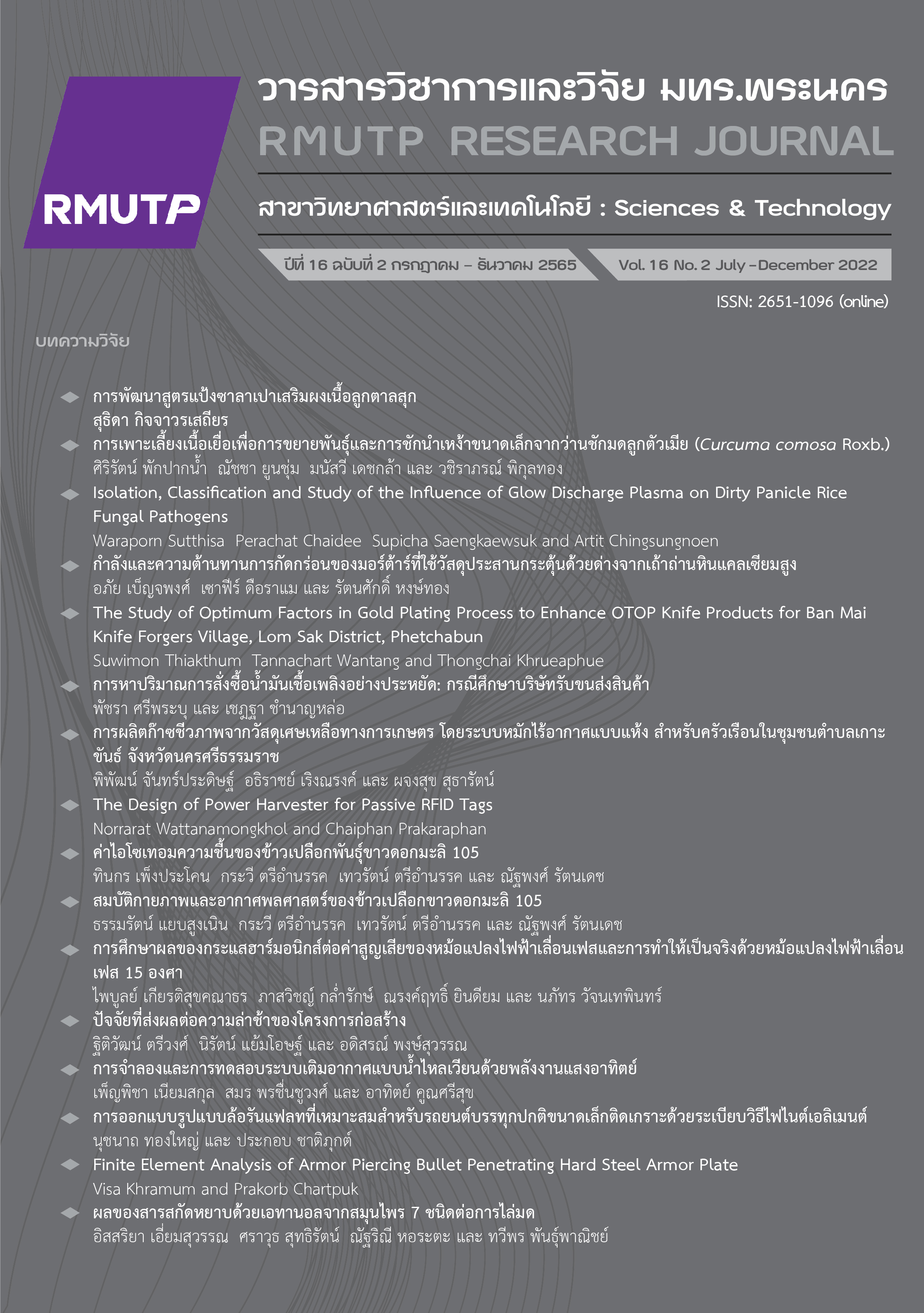Finite Element Analysis of Armor Piercing Bullet Penetrating Hard Steel Armor Plate
Main Article Content
Abstract
The bulletproof plates with materials that can convincingly be destroyed by the 7.62 mm bullet with its speed at 878 ± 9.1 m/s were developed by designing according to the National Institute of Justice Level 4 (NIJ 4). The plates were made of two flat sheets stacking, SKD11 and SUS304. Their components were composed of the front and back plates; the first sheet made of SKD11 material hardening at 65 HRC with a thickness of 6 mm and the back plate made of SUS 304 material with a thickness of 5 mm. The finite element method was applied to simulate and analyze the results to demonstrate the bullet resistance to the perforation by setting perpendicular sheet to the bullets. Therefore, the simulating studies for the bullet firing were demonstrated by locating its angles of 15, 30, 45 and 60 degrees to the SKD11 sheet with a thickness of 6, 8, and10 mm coupled with the SUS304 sheet with a thickness of 5, 6, 8, and 10 mm. These plates were stacking into two layers then the finite element method was applied to simulate one at a time. The results showed that the first sheet of SKD11 with 6 mm of thickness could resist the perforation of the bullet at 60 degree and the plate thickness of 8 and 10 mm could start resisting to the perforation at 45 degree. The second sheet of SUS304 with the thickness of 5, 6, 8, and 10 mm were incapable to resist to the perforation and the refraction of the bullet direction as good as that of SKD11. Therefore, the principle applying two metal sheets stacked into layers was essential to impel the resistance of the bullet perforation and change the direction of the bullet.
Article Details

This work is licensed under a Creative Commons Attribution-NonCommercial-NoDerivatives 4.0 International License.
ลิขสิทธ์ ของมหาวิทยาลัยเทคโนโลยีราชมงคลพระนครReferences
M. A. Iqbal, K. Senthil, P. Bhargava, and N. K. Gupta, “The characteri-zation and ballistic evaluation of mild steel,” International Journal of Impact Engineering, vol. 78, pp. 98–113, Apr. 2015.
T. Børvik, L. Olovsson, S. Dey, and M. Langseth, “Normal and oblique impact of small arms bullets on AA6082-T4 aluminium protective plates,” Int. J. Impact Eng., vol. 38, no. 7, pp. 577–589, Jul. 2011.
T. Binar et al., “The use of numerical simulation for the evaluation of special transparent glass resistance,” Eng. Fail. Anal., vol. 91, pp. 433–448, Sep. 2018.
B. Banerjee, “An evaluation of plastic flow stress models for the simulation of high-temperature and high-strain-rate deformation of metals,” p. 53, Dec. 2005.
M. A. Iqbal, K. Senthil, V. Madhu and N. K. Gupta, “Oblique impact on single, layered and spaced mild steel targets by 7.62 AP projectiles,” Int. J. Impact Eng., vol. 110, pp. 26–38, Dec. 2017.
J. L. Li, L. L. Jing and M. Chen, “An FEM study on residual stresses induced by high-speed end-milling of hardened steel SKD11,” J. Mater. Process. Technol., vol. 209, no. 9, pp. 4515–4520, May 2009.
N. Klangtup and P. Chartpuk, “Parameter analysis of SKD11 and SUS304 bulletroof plate that resistance penetration of bullet 7.62 mm according to standard NIJ 4 by finite element method,” International Journal of Mechanical Engineer and Technology, vol. 10, pp. 207–221, Sep. 2019.
A. Saicharoen, P. Tinprabath and P. Chartpuk, “Parameter Analysis that Affects the Ability to Resistance Penetration of Ammunition on the Aluminum Armor Surface Using Finite Element Method,” RMUTP Research Journal, vol. 16, no. 1, pp. 177-191, 2022.
F. M. John, T. Jan Arild, S. Stian, B. Svien Morten, S.-E. Lasse and F. Haakon, “Development of material models for semi-brittle materials like tungsten carbide,” 09-Nov-2010.
“Steinberg-Guinan Strength.” [Online]. Available: https://www.sharcnet.ca/Software/Ansys/16.2.3/enus/help/wb_sim/ds_ex_mat_steingui.html.
K. Krishnan, S. Sockalingam, S. Bansal, and S. D. Rajan, “Numerical simulation of ceramic composite armor subjected to ballistic impact,” Compos. Part B Eng., vol. 41, no. 8, pp. 583–593, Dec. 2010.
P. K. Gupta, M. A. Iqbal, and Z. Mohammad, “Energy dissipation in plastic deformation of thin aluminum targets subjected to projectile impact,” Int. J. Impact Eng., vol. 110, pp. 85–96, Dec. 2017.
M. A. Iqbal, A. Chakrabarti, S. Beniwal and N. K. Gupta, “3D numerical simulations of sharp nosed projectile impact on ductile targets,” International Journal of Impact Engineering, vol. 37, no. 2, pp. 185–195, Feb. 2010.


